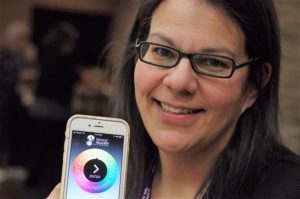Restorative practices and self-care among highlights at Nokiiwin Tribal Council’s conference

By Rick Garrick
THUNDER BAY—Workshops on restorative practices and self-care were among the highlights at Nokiiwin Tribal Council’s ‘An Inside Job Our Journey Away from Lateral Violence’ conference in Thunder Bay.
“Restorative practices [are] basically a way of building relationships between people to help people better understand each other and support each other better so that when you run into conflict, you have relationships that resolve easier,” says Nicole Richmond, a consultant with Nokiiwin who presented the ‘Using Restorative Practices to Strengthen Relationships and Reduce and Repair Harm Arising from Conflict’ workshop. “It’s an alternative dispute resolution process that basically works on repairing relationships rather than finding someone culpable or punishing someone.”
Richmond, a Biigtigong Nishnaabeg citizen, says restorative practices are used in classrooms in the Superior-Greenstone District School Board, which is where she learned about them.
“You can bring people into a circle and you can have discussions,” Richmond says. “If it comes around in the circle, they will respond but they might not respond otherwise. So it’s a way to have quiet voices heard.”
Richmond says restorative practices can also be used in the workplace to build employee rapport or to help people understand one another.
“The third thing you can use this for is if you have a criminal charge that can be diverted, we can have restorative justice circles to actually repair harm,” Richmond says. “So rather than someone going to jail or going for trial, the charge can be diverted to a restorative circle. So that is what we are working on right now for Nokiiwin.”
Melissa Desmoulin, conference community outreach worker with Biidaaban Healing Lodge and a Biigtigong Nishnaabeg citizen, helped present the Self Care workshop on ways for people to build their own spirits.
“A lot of times when we are in the helping field, we always encourage our clients and our people to take care of themselves, but as workers we tend to sometimes forget to take care of ourselves,” Desmoulin says. “It’s like that airplane theory, you’ve got to put the mask on yourself first before you can help other people. So that’s what we’re doing.”
Biinjitiwaabik Zaaging Anishinaabek Elder and former Chief Patrick Hardy wants to see more emphasis on Anishinaabemowin skills after hearing how students in La Loche lost their Dene language skills once they attended school during the La Loche presentation by keynote speaker Caitlyn Wood.
“It seemed that losing their language really bothered them,” Hardy says. “What I said yesterday was that we are about one generation away from losing our language.”
The two-day health, safety and wellness conference was held to address how lateral violence impacts Indigenous people inside the home, community and workplace and to promote new approaches for creating safer spaces from within.
“The roots of violence in our First Nations today stem from decades of colonization, oppression, intergenerational trauma and ongoing experiences of racism, among other factors,” says Audrey Gilbeau, Nokiiwin’s executive director. “As Indigenous peoples, we often turn our personal pain onto our own people, and the result is violence in our homes, schools, communities and workplaces. This conference brings back our traditional ways, teachings, skills and practices to restore healthy homes, schools, communities and workplaces from the inside out.”
The conference also included a Spirit Builder Workshop that provided a community model to tackle the issues of historic trauma and a Woman is Medicine: Restoring our Well-Being workshop by Tamara Bernard.
Nokiiwin provides services to six First Nation communities, including Biinjitiwaabik Zaaging Anishinaabek, Pic Mobert and Fort William.


